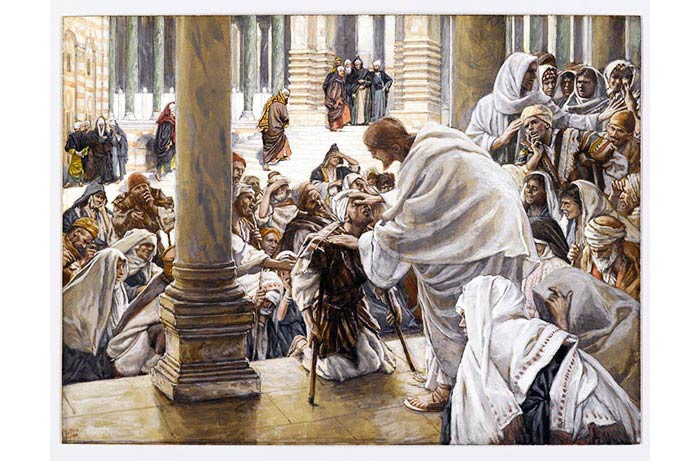God created us out of love. He wanted to share his very life with us. The fellowship and communion that he desired was broken, however, when Adam and Eve sinned in the garden of Eden. Because of their disobedience, humanity was separated from God and became subject to sickness, suffering, and death. Yet in his great mercy, God promised to reverse the consequences of this first sin. He fulfilled that promise in Jesus Christ, the Word made flesh.
Entrusted with his Father’s mission to redeem mankind, Jesus began his public ministry, “teaching in their synagogues and proclaiming the good news of the kingdom and curing every disease and every sickness among the people” (Matthew 4:23). Indeed, after being anointed by the Spirit at his baptism, he identified himself as the one of whom the prophet Isaiah had spoken:
“The Spirit of the Lord is upon me,
Luke 4:18-19 (see also Isaiah 61:1-2)
because he has anointed me
to bring good news to the poor.
He has sent me to proclaim release to the captives
and recovery of sight to the blind,
to let the oppressed go free,
to proclaim the year of the Lord’s favor.”
“Today this scripture has been fulfilled in your hearing” (Luke 4:21), Jesus declared to his fellow townspeople in the synagogue at Nazareth. Jesus accompanied his teaching “with ‘mighty works and wonders and signs’ [Acts 2:22], which manifest that the kingdom is present in him and attest that he was the promised Messiah” (quote from Catechism of the Catholic Church 547).
Power Came Out from Him
The Greek word for “power,” dunamis, is the also the root of the word “dynamic.” Divine power and dynamism radiated from Jesus and drew people to him: “All in the crowd were trying to touch him, for power came out from him and healed all of them” (Luke 6:19). In confronting sickness, sin, Satan, and even death, Jesus acted with the power and sovereign authority that were his as the Son of God, the Messiah-Redeemer.
Jesus’ miracles did more than manifest his mighty power, though. They also communicated the love and compassion of God for his people. Jesus performed healings on the Sabbath—among them, restoring a man’s withered hand and straightening the bent back of a woman—even though he knew he would be criticized by the Pharisees for doing so. He sometimes cured people of their physical ailments while at the same time healing them spiritually by forgiving their sins. The gospels often tell of Jesus’ compassion when he performed a miracle, such as the time when he restored the life of the widow’s only son in Nain (Luke 7:11-23).
Although there’s no doubt that Jesus’ miracles made a sensation, he didn’t perform miracles to call attention to himself or enhance his reputation. In fact, he refused to do extraordinary deeds for his own advantage or glorification, rejecting Satan’s urgings to turn stones into bread and to display his power by throwing himself from the pinnacle of the temple. He also refused to satisfy the Sadducees’ and Pharisees’ demand to “show them a sign from heaven” (Matthew 16:1-4) and Herod’s desire to “see him perform some sign” (Luke 23:8). Rather, the miracles Jesus worked demonstrated his divine mission of redemption and expressed the saving power and mercy of God.
Accounts of Jesus’ miracles make up a significant portion of the text of the gospels and record the variety of ways he revealed his divine power. Some restored people to wholeness and well-being through physical healing, the forgiveness of sins, or deliverance from evil spirits. Several revealed Jesus’ authority over natural elements, such as when he multiplied the loaves and fish, transformed water into wine at Cana, and calmed a violent storm. Still other miraculous events—for instance, Jesus’ transfiguration and his walk on the waters of the Sea of Galilee – were “epiphanies” of Jesus’ glory.
These extraordinary deeds were not merely physical marvels that overturned the laws of nature. Rather, they were divine acts that transcended the natural order of the physical world – reminders that the kingdom of God transcends that physical world, as well. Theologically speaking, Jesus’ miracles were “above nature;” signs that, in the spiritual order, had moral and religious character and revealed the nature and goodness of God.
Although the scribes and Pharisees didn’t deny Jesus’ ability to perform miraculous healings, they challenged the authority with which he performed them. Despite the evidence, some people rejected Jesus; others even accused him of acting by the power of Satan. Among the reasons why the chief priests and Pharisees sought to kill Jesus was that they felt threatened by his power to work miracles and by his growing popularity with the crowds who witnessed them.
Historical Realities
The public character of Jesus’ miracles is clearly recorded. From a historical perspective, it is indisputable that Jesus was recognized as a healer. His deeds were known by the crowds and generated great excitement among those who witnessed them. Indeed, it was because of his miraculous works that many regarded him as a great prophet. There is no evidence that Jesus’ contemporaries denied the fact that he worked miracles, even though they disputed that God was the source of his ability to perform them. The miraculous nature of Jesus’ deeds was confirmed by many eyewitnesses who later passed on accounts of them to the early Christian communities.
Jesus’ miracles are not to be dismissed simply as ordinary events given grander meanings through the eyes of faith. They are actual physical realities that cannot be explained by natural or earthly causes. Nor are they mere symbols – although they do indeed contain symbolic resonances and a depth of symbolic meaning. The gospels not only record the memory of the actual events but often reveal the many levels of meaning also found in them. For example, the healing of the blind man recounted in John 9 illustrates not only the restoration of the man’s physical sight but also the removal of spiritual blindness and the attainment of spiritual insight and enlightenment. Similarly, Jesus’ calming of the tempestuous wind and waves with a word of command points to the care and protection he still exercises over the church when it faces “storms.” Feeding the hungry crowds by multiplying the loaves is a sign that Jesus himself is the Bread of Life and also alludes to the messianic banquet at the end of time. That these miraculous events have symbolic, theological, and ecclesial meanings contained in them does not discredit or reduce the authenticity of the miracles themselves.
Occasionally the accounts of Jesus’ miracles vary in their details and their chronological placement in the gospels. Such variations reflect the processes by which the gospel tradition took shape and the way in which the gospels were written. First, Jesus worked his miracles. Then witnesses of these miracles recounted what they had seen as a way of spreading the good news of the salvation Jesus had brought. These oral stories were repeated and handed down over the years, and some were recorded in writings that predate the gospels. Finally, under the inspiration of the Holy Spirit, Matthew, Mark, Luke, and John drew upon all the material they found in the church’s living tradition and wrote their gospels. When the original chronology of Jesus’ actions or particular miracles was uncertain to them, they inserted them into the literary structure of their gospels with careful consideration of where these miracles would appropriately illustrate Jesus’ mission and underscore his teachings.
The Evangelists did not invent or embellish the stories of Jesus’ miracles, but they did present them from their individual perspectives and points of view. Mark’s gospel closely associates Jesus’ miracles with the proclamation of the good news of the kingdom, and through them reveals the person of Jesus, his power, his mission of redemption, and the establishment of God’s reign. The Gospel of Matthew offers the outlook of an instructor or catechist, with its author highlighting people’s professions of faith in Jesus, ways in which Jesus fulfilled Old Testament prophecies, and the significance of his teachings and miracles to the developing church. The gospel written by the physician-Evangelist Luke portrays Jesus as the prophet-Messiah sent by God to bring salvation and deliverance. Luke records Jesus’ miracles – frequently with some medical detail—in the framework of Jesus’ teachings, in order to illustrate how the kingdom of God was made present. John chose to recount only seven of Jesus’ miracles, and he presented them as “signs” and “works” that manifested Christ’s glory and bore witness that he had been sent by God.
Good News Made Visible
Jesus’ miracles are, in fact, rich in their “sign value.” Noted theologian and Scripture scholar René Latourelle has called them “the good news itself made visible.”1 We recognize in them signs of the power of God, signs of the coming of the Messiah and of the kingdom of God, signs of the compassion and love of God, signs of Christ’s glory, and signs of the age to come.
Jesus himself pointed to the messianic signs foretold by Isaiah, which were fulfilled in him. When the disciples of John the Baptist asked, “Are you the one who is to come, or are we to wait for another?” Jesus said, “Go and tell John what you hear and see: the blind receive their sight, the lame walk, the lepers are cleansed, the deaf hear, the dead are raised, and the poor have good news brought to them” (Matthew 11:2-5; see also Isaiah 35:5-6).
When the apostle Peter addressed the Israelites on Pentecost, he told them of Jesus of Nazareth and the “deeds of power, wonders, and signs that God did through him among you” (Acts 2:22). Later, he spoke to the gentile Cornelius and his household of “how God anointed Jesus of Nazareth with the Holy Spirit and with power; how he went about doing good and healing all who were oppressed by the devil, for God was with him” (10:38). “The signs worked by Jesus attest that the Father has sent him. They invite belief in him. To those who turn to him in faith, he grants what they ask. So miracles strengthen faith in the One who does his Father’s works; they bear witness that he is the Son of God” (quote from Catechism of the Catholic Church 548).
The miracles that Jesus performed announced that the kingdom of God was breaking forth in the world. By his marvelous acts of healing and forgiveness, Jesus showed God’s mercy toward those who were without hope – the weak, the ill, the sinful. The Son of God used his divine power in the service of love, moved with pity toward those in distress. Thus, “Christ’s compassion toward the sick and his many healings of every kind of infirmity are a resplendent sign that ‘God has visited his people’ and that the Kingdom of God is close at hand” (quote from Catechism of the Catholic Church, 1503).
The Greek word simeion – “sign” – is used seventeen times in the Gospel of John and sixty times throughout the rest of the New Testament. Chapters 1–12 of John’s gospel have been called the Book of Signs because of the sign-miracles described there. For John, the mighty deeds that Jesus performed were signs that “revealed his glory” (John 2:11) as well as the power of God working through him.
Finally, while the miracles occurred in the physical world of Jesus’ day, they also prefigure greater realities to come when “a new heaven and earth” (Isaiah 65:17; 2 Peter 3:13; Revelation 21:1) will be revealed. Restoring health to the ill and life to those who have died hints at the transformation that will take place at the end of time, when “this perishable body puts on imperishability, and this mortal body puts on immorality” (1 Corinthians 15:53).
Jesus’ Invitation to Us
When Jesus worked miracles two thousand years ago, he manifested his love and compassion and called men and women to faith in him and his mission. These miraculous events still have something to say to us: they are Jesus’ invitation to open ourselves to receive his mercy and to embrace the salvation he came to proclaim to us.
Today God continues to work miracles in our midst to bring us to wholeness and deeper conversion to him. Just as the father who sought freedom and deliverance for his child cried, “Lord, I believe; help my unbelief!” (Mark 9:24), so can we ask God to increase our faith. And just as the woman with the hemorrhage reached out to Jesus, saying and knowing in her heart, “If I only touch his cloak, I will be made well” (Matthew 9:21), so can we reach out to him now. Jesus is eager to answer us with miraculous signs of his presence and love and healing power.
This article is excerpted from Mighty in Power: The Miracles of Jesus by Jeanne Kun (Copyright © 2004), published by The Word Among Us Press. Used with permission.
Top image credit: Jesus heals a blind and lame man, illustration by James Tissot, in the Brooklyn Museum, New York City. Image in the Public Domain.
Jeanne Kun is a noted author, and a member of Bethany Association, an international, ecumenical association of women living single for the Lord in various communities of The Sword of the Spirit, and a senior woman leader in the Word of Life Community, Ann Arbor, Michigan, USA.



